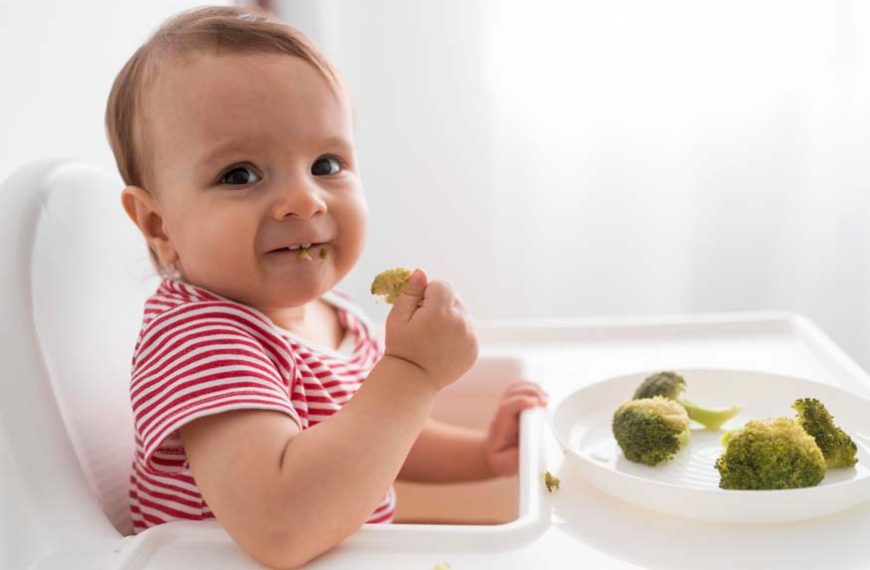The transition from liquid diets to solid foods is a significant milestone for toddlers and parents alike. Navigating this journey requires keen observation, a balanced approach, and a touch of patience. While it’s tempting to dive into this new phase eagerly, it’s essential to recognize the signs that indicate your baby is ready for this transition. Understanding your baby’s cues will not only make the process smoother but also ensure their health and development are supported.
What Do We Mean by Transitioning to Solid Food?
What is solid food? And what does moving to solid food indicate, really? Moving to solid foods refers to the transition in an infant’s or toddler’s diet from solely consuming breast milk or formula to incorporating more diverse and textured foods. This developmental milestone typically occurs around the age of six months but can vary from child to child. Moving to solid foods involves gradually introducing a variety of foods with different textures, tastes and nutritional profiles.
Identifying Your Toddler’s Readiness for Solid Food
Let’s explore the key indicators that reveal when your baby is ready to have a go at solid foods.
- Age Matters, But It’s Not Everything:
- Head Control:
- Interest in Watching Others Eat:
- Loss of Tongue Thrust Reflex:
- Improved Hand-Eye Coordination:
- Sustained Weight Gain:
- Increased Appetite and Shorter Feeding Intervals:
Traditionally, many parents have relied on age as the most important of signs of readiness for solid foods. But it’s important to remember that every baby is unique, and readiness for solids varies. Some babies may show signs of readiness earlier, while others might need a bit more time.
One of the crucial signs of readiness for solid foods to look for is your baby’s ability to hold their head steady. To safely consume solid foods, your baby needs to have sufficient neck and head control to sit upright. This ensures that they can swallow and digest food properly, reducing the risk of choking.
Babies are excellent observers. If your little one starts showing interest in watching others eat, reaching for your food or mimicking chewing motions, it could be a sign that they are curious about what’s on your plate. This interest indicates a natural curiosity about food and can be a positive cue for when to give baby solid food.
Babies are born with a tongue thrust reflex that pushes food out of their mouths. Around the age of four to six months, many babies start to lose this reflex, a sign that their digestive system is maturing. When the tongue thrust reflex diminishes, it becomes easier for babies to move from a liquid-only diet to more textured foods.
The ability to coordinate hand movements and bring objects to the mouth is an essential developmental milestone. If your baby starts reaching for objects or attempting to bring toys or hands to their mouth with increased coordination, it suggests they may be ready to explore different textures and tastes.
While not the sole indicator, sustained and appropriate weight gain is an important consideration when introducing solids. If your baby has been steadily gaining weight on a breast milk or formula diet, it may be a good sign that their digestive system is ready for the added nutrients solid foods provide.
If you notice your baby seems unsatisfied with milk alone, wanting to feed more frequently, or seeming hungrier sooner after a feeding, it could be a signal that they need additional nutrients. This increased appetite may indicate a readiness for when to introduce solid food to baby for a nutritional boost.
Types of Solid Foods to Introduce First:
Here are the broad categories of solid foods that you need to research, which can help you prepare your little ones for what is solid food transitioning:
- Single-Ingredient Purees:
- Soft, Cooked Vegetables and Fruits:
- Cereals and Grains
Start with single-ingredient purees like mashed bananas, avocados, or sweet potatoes. These solid food examples are easy to digest and help toddlers adjust to new textures.
Gradually introduce soft, cooked vegetables and fruits, such as peas, carrots and apples. Cutting them into small, bite-sized pieces minimizes the risk of choking.
Fortified cereals and grains provide essential nutrients. Opt for whole grains like oatmeal or rice, and consider mixing them with breast milk or formula for familiar flavors.
Foods to Avoid for Toddlers:
But remember, not all solids are safe for your toddlers to eat just yet. Stay clear of these solid food examples:
- Choking Hazards:
- High-Sugar and Processed Foods:
- Honey and Allergens:
Avoid foods that pose a choking risk, such as whole grapes, hot dogs, nuts and popcorn. Cut foods into small, manageable pieces to reduce this risk.
Limit the intake of high-sugar and processed foods. Opt for whole, nutrient-dense options to support your toddler’s growth and development.
Refrain from giving honey to children under one year due to the risk of infant botulism. Additionally, introduce potential allergens one at a time and monitor for any adverse reactions.
How to Encourage the Transition to Solid Foods
Encouraging the transition to solid foods is a delicate process that involves creating a positive and enjoyable eating experience for your baby. Here are some practical tips to facilitate a smooth transition:
- Lead by Example:
- Introduce One Food at a Time:
- Gradual Progression of Texture:
- Create a Positive Mealtime Atmosphere:
- Offer Finger Foods:
- Praise and Encouragement:
- Be Patient and Flexible:
- Maintain a Consistent Schedule:
- Explore Different Flavors:
- Monitor Signs of Fullness:
Eating together as a family can have a significant impact on your baby’s willingness to try new foods. Babies are naturally curious and often imitate the behaviors of those around them. When they see you enjoying a variety of foods, it can spark their interest and curiosity.
Start with single-ingredient purees or soft, mashed foods. Introducing one new food at a time allows you to monitor your baby for any potential allergies or sensitivities. It also helps your baby become familiar with individual flavors and textures.
Begin with smoother textures and gradually progress to lumpier or more textured foods as your baby becomes comfortable with swallowing. This progression helps them develop the necessary oral motor skills for chewing.
Make mealtime a fun and stress-free experience. Use colorful plates and cheerful utensils, and create a comfortable and inviting environment. Avoid pressuring your baby to eat and instead focus on making the experience enjoyable.
As your baby becomes more adept at picking up objects, introduce soft finger foods. These can include small pieces of well-cooked vegetables, fruit slices or small portions of cooked pasta. The tactile experience of handling food can be both entertaining and beneficial for their motor skills.
Celebrate small victories and cheer your toddlers on, when they try new foods. Positive reinforcement can create a positive association with eating and help build their confidence in exploring a variety of tastes and textures.
Every baby is unique and the transition to solid foods can vary. Be patient and flexible, adjusting your approach based on your baby’s cues and preferences. Some babies may take to solids quickly, while others may need more time to adapt.
Establish a regular feeding schedule to create a sense of routine for your baby. Consistency in mealtime can help them anticipate when to expect food, making the transition smoother.
Introduce a variety of flavors to expand your baby’s palate. Experiment with different fruits, vegetables, and grains to provide a diverse range of nutrients and encourage an appreciation for various tastes.
Pay attention to your baby’s cues of fullness. If they turn their head away, close their mouth or lose interest in eating, respect these signals. Avoid pressuring your baby to finish every bite and allow them to self-regulate their food intake.
By approaching the transition to solid foods with patience, positivity and compassion, you can create a nurturing environment that encourages your baby to explore and enjoy the wonderful world of food. Remember that this is a developmental journey, and each step, no matter how small, is a significant accomplishment for your growing little one. For more information, visit EuroKids.
















